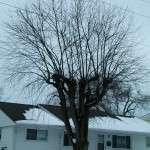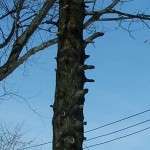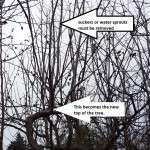Pruning Tips for Shade and Fruit Trees
Categories: News
Let’s talk about the principles of approved pruning practices now that we are into the winter season and there is a limited amount of outdoor work we can do in our yards.
Shade Trees
 First, let’s take a look at what we need to do to protect our investment in shade trees. When trees are placed in the proper location and are maintained they provide huge benefits for property owners. Trees increase property values, reduce energy costs, provide a better environment for our living, a better habitat for wildlife and improve the beauty of our surroundings all year long. This is true ONLY when our trees are in good condition. Developing the basic scaffold branching and other key structural items is important when trees are at a young age. If large shade trees are not maintained or are butchered, by “topping”, they can become a major liability and very costly to remove.
First, let’s take a look at what we need to do to protect our investment in shade trees. When trees are placed in the proper location and are maintained they provide huge benefits for property owners. Trees increase property values, reduce energy costs, provide a better environment for our living, a better habitat for wildlife and improve the beauty of our surroundings all year long. This is true ONLY when our trees are in good condition. Developing the basic scaffold branching and other key structural items is important when trees are at a young age. If large shade trees are not maintained or are butchered, by “topping”, they can become a major liability and very costly to remove.
 Two of the photos included here show examples of properly versus poorly pruned shade trees. The tree with the open branching has been thinned out and allows wind to blow through the tree without damage. It provides filtered sunlight through the canopy for plants that are growing nearby while providing a great environment for us. The photo of the tree that has been “topped” has excessive suckers and many dead “stubs” that will provide entry points for insects and decay leading to the eventual destruction of the tree.
Two of the photos included here show examples of properly versus poorly pruned shade trees. The tree with the open branching has been thinned out and allows wind to blow through the tree without damage. It provides filtered sunlight through the canopy for plants that are growing nearby while providing a great environment for us. The photo of the tree that has been “topped” has excessive suckers and many dead “stubs” that will provide entry points for insects and decay leading to the eventual destruction of the tree.
When pruning younger trees, remove lower branches that will interfere with movement around the tree. These branches do not gain in elevation from the ground as the tree grows, and must be removed. Never leave any stubs as shown in the tree in figure 3. Again, these stubs die and become entry points for disease and decay.
The dormant season, like we are in now, is a good time to prune your shade trees so they are ready to grow in the spring, in all the right places. Pruning smaller trees can be done by the homeowner when basic guidelines are followed. Larger trees will require a certified arborist to take care of the pruning that is required.
For more on the basics of pruning and info on proper pruning of shade trees go to http://extension.missouri.edu/p/g6866 or https://extension.unh.edu/resources/files/Resource000595_Rep617.pdf
Fruit Trees
Second, it is a good time to prune apple, peach, plum, pear trees if they need it.
Take a look at the picture of a dormant bud that will flower and could bear fruit. Look for the different types of buds so you can avoid cutting off any future apples or other fruit from your trees. You will notice that the fruiting buds or “spurs” are a little larger and are on stubby short stems called spurs. They will continue to swell up over the winter as the flower matures before blooming. The leaf buds are smaller and close to the stem. We have been referring to an apple tree but the same principles apply to all fruit trees.
There are two primary things to do when pruning fruit trees. 1) Remove suckers or water sprouts. These are usually long, un-branched, very upright growth with no flower buds. 2) Remove any branches that are rubbing one another or are growing toward the center of the tree. The principle thing we are trying to do is to remove unproductive branches and open up the center of the tree so plenty of light and air movement are available to the tree and the developing fruit. Do not leave stubs on the tree when removing branches. Make your cuts with the flat side of your pruning shears up against the tree so your prune is close to the remaining part of the tree.
We hope this info helps you get started with your pruning and harvesting a lot of good home grown produce.
For more information go to http://estore.osu-extension.org/productdetails.cfm?PC=2337 and look for Bulletin 940, Midwest Home Fruit Production Guide. This is an excellent resource, for just $23.00. The 148 page booklet covers all phases of the growing fruit here in Ohio. There are 269 color photos/illustrations to show gardeners how to grow fruit plants and how to identify and manage fruit pests and diseases. This bulletin is an excellent reference for anyone with an interest in home fruit production. It is especially useful for home gardeners.








Comments are closed.